 W
WThe American Cryptogram Association (ACA) is an American non-profit organization devoted to the hobby of cryptography, with an emphasis on types of codes, ciphers, and cryptograms that can be solved either with pencil and paper, or with computers, but not computer-only systems.
 W
WBack from the Klondike is one of Sam Loyd's most famous puzzles, first printed in the New York Journal and Advertiser on April 24, 1898. In introducing the puzzle, Loyd describes it as having been constructed to specifically foil Leonhard Euler's rule for solving any maze puzzle by working backwards from the end point.
 W
WA balance puzzle is a mathematical puzzle which challenges the solver to distribute a subset of numbers so that the several sides of a stylized diagram representing a balance scale are equal. The balance puzzle is a classical number puzzle in the World Puzzle Championship. It consists in a mobile or tree structure, with designated positions where the player must hang specified weights, so that everything balances. See examples below.
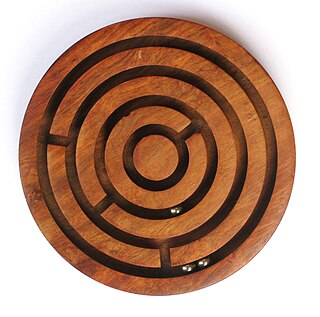 W
WBall-in-a-maze puzzles are dexterity puzzles which involve manipulating either a maze or one or several balls so that the ball or balls are manoeuvered towards a goal. Toys like this have been popular since "Pigs in Clover" was invented by Charles Martin Crandall in the 1880s, with the patent being applied for in 1889.
 W
WA Bongard problem is a kind of puzzle invented by the Russian computer scientist Mikhail Moiseevich Bongard, probably in the mid-1960s. They were published in his 1967 book on pattern recognition. The objective is to spot the differences between the two sides. Bongard, in the introduction of the book credits the ideas in it to a group including M. N. Vaintsvaig, V. V. Maksimov, and M. S. Smirnov.
 W
WThe cat hair mustache puzzle is a puzzle in the video game Gabriel Knight 3: Blood of the Sacred, Blood of the Damned. The puzzle's name is owed to the use of cat hair as a fake mustache, which protagonist Gabriel Knight uses as part of a disguise in order to steal a man's motorcycle rental. The puzzle was created by the game's producer, Steven Hill, following a puzzle being worked on by the game's creator, Jane Jensen, having to be cut due to budgetary reasons. The designers disliked the puzzle, but because of time constraints, it had to be left in.
 W
WA combination puzzle, also known as a sequential move puzzle, is a puzzle which consists of a set of pieces which can be manipulated into different combinations by a group of operations. Many such puzzles are of a polyhedral shape, and consist of multiple layers of pieces along each many axes which can rotate independently of each other.
 W
WConnect the dots is a form of puzzle containing a sequence of numbered dots. When a line is drawn connecting the dots the outline of an object is revealed. The puzzles frequently contain simple line art to enhance the image created or to assist in rendering a complex section of the image.
 W
WA crossword is a word puzzle and word search game that usually takes the form of a square or a rectangular grid of white- and black-shaded squares. The game's goal is to fill the white squares with letters, forming words or phrases, by solving clues, which lead to the answers. In languages that are written left-to-right, the answer words and phrases are placed in the grid from left to right and from top to bottom. The shaded squares are used to separate the words or phrases.
 W
WFamous Trick Donkeys is a puzzle invented by Sam Loyd in 1858, first printed on a card supposed to promote P.T. Barnum's circus. At that time, the puzzle was first called "P.T. Barnum's trick mules". Millions of cards were sold, with an estimated income for Sam Loyd of $10,000 from 1871—about $200,000 in 2014 dollars.
 W
WThis classical, popular puzzle involves a large rectangle divided into five "rooms". The objective of the puzzle is to cross each "wall" of the diagram with a continuous line only once.
 W
WThe Goat Puzzle, also known as The Infamous Goat Puzzle, The Infamous Goat, The Wretched Goat, The Goat of Lochmarne, or simply The Goat, is a puzzle featured in Revolution Software's 1996 point and click adventure game Broken Sword: The Shadow of the Templars. In the puzzle, protagonist George Stobbart must gain access to an underground dig located in a castle in Lochmarne, Ireland, by avoiding getting butted by a fierce goat. It is often explained to be difficult due to challenging the player in a way different from previous puzzles in the game. It is also noted by many gamers and various publications as one of the hardest video game puzzles of all time. The puzzle was simplified in The Shadow of the Templars' 2009 director's cut.
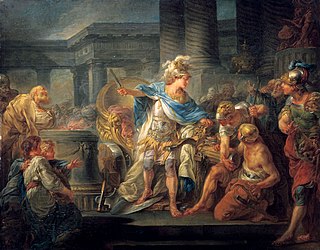 W
WThe Gordian Knot is a legend of Phrygian Gordium associated with Alexander the Great. It is often used as a metaphor for an intractable problem solved easily by finding an approach to the problem that renders the perceived constraints of the problem moot :
 W
WIn Greek mythology, the Labyrinth was an elaborate, confusing structure designed and built by the legendary artificer Daedalus for King Minos of Crete at Knossos. Its function was to hold the Minotaur, the monster eventually killed by the hero Theseus. Daedalus had so cunningly made the Labyrinth that he could barely escape it after he built it.
 W
WA logogriph is a form of word puzzle based on the component letters of a key word to be identified, and is derived from Greek λόγος, a word, and γρίφος, a riddle or fishing basket. It generally involves anagrams or other wordplay treatments such as addition, subtraction, omission, or substitution of a letter, and is sometimes arranged in the form of a verse giving hints to the word. The term logogriph is also used for the puzzle type in which a pair of anagrams must be deduced from synonyms.
 W
WMathematical puzzles make up an integral part of recreational mathematics. They have specific rules, but they do not usually involve competition between two or more players. Instead, to solve such a puzzle, the solver must find a solution that satisfies the given conditions. Mathematical puzzles require mathematics to solve them. Logic puzzles are a common type of mathematical puzzle.
 W
WA maze is a path or collection of paths, typically from an entrance to a goal. The word is used to refer both to branching tour puzzles through which the solver must find a route, and to simpler non-branching ("unicursal") patterns that lead unambiguously through a convoluted layout to a goal. The pathways and walls in a maze are typically fixed, but puzzles in which the walls and paths can change during the game are also categorised as mazes or tour puzzles.
 W
WA mechanical puzzle is a puzzle presented as a set of mechanically interlinked pieces in which the solution is to manipulate the whole object or parts of it. One of the most well-known mechanical puzzles is Ernő Rubik’s Cube that he invented in 1974. The puzzles are mostly designed for a single player where the goal is for the player to see through the principle of the object, not so much that they accidentally come up with the right solution through trial and error. With this in mind, they are often used as an intelligence test or in problem solving training.
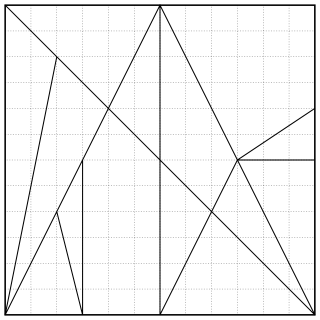 W
WOstomachion, also known as loculus Archimedius and also as syntomachion, is a mathematical treatise attributed to Archimedes. This work has survived fragmentarily in an Arabic version and a copy, the Archimedes Palimpsest, of the original ancient Greek text made in Byzantine times. The word Ostomachion has as its roots in the Greek Ὀστομάχιον, which means "bone-fight", from ὀστέον (osteon), "bone" and μάχη (mache), "fight, battle, combat". Note that the manuscripts refer to the word as "Stomachion", an apparent corruption of the original Greek. Ausonius gives us the correct name "Ostomachion". The Ostomachion which he describes was a puzzle similar to tangrams and was played perhaps by several persons with pieces made of bone. It is not known which is older, Archimedes' geometrical investigation of the figure, or the game. Victorinus, Bassus Ennodius and Lucretius have talked about the game too.
 W
WPerplexus is a 3-D ball-in-a-maze puzzle or labyrinth game enclosed in a transparent plastic sphere. By twisting and turning the sphere, players attempt to maneuver a small steel ball through an intricate maze composed of a number of steps along narrow plastic tracks. The number of steps ranges from 30 in the Perplexus Twist to 125 in the Perplexus Epic. Some of the steps involve dropping the ball into a cup or through a small rim to take advantage of its three-dimensional nature. There are obstacles of varying difficulty that must be navigated in order to reach the end.
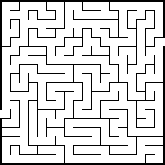 W
WA picture maze is a maze puzzle that forms a picture when solved.
 W
WProject Euler is a website dedicated to a series of computational problems intended to be solved with computer programs. The project attracts adults and students interested in mathematics and computer programming. Since its creation in 2001 by Colin Hughes, Project Euler has gained notability and popularity worldwide. It includes over 700 problems, with a new one added once every one or two weeks. Problems are of varying difficulty, but each is solvable in less than a minute of CPU time using an efficient algorithm on a modestly powered computer. As of 5 April 2020, Project Euler has more than 1,000,000 users, from all over the world, who have solved at least one problem.
 W
WA rattleback is a semi-ellipsoidal top which will rotate on its axis in a preferred direction. If spun in the opposite direction, it becomes unstable, "rattles" to a stop and reverses its spin to the preferred direction.
 W
WRubik's Brain Racker is a single-player puzzle in the Rubik's line. The puzzle comes with numerous goals to work on and achieve. It was published by Winning Moves Games USA in 2007.
 W
WThe Seven Bridges of Königsberg is a historically notable problem in mathematics. Its negative resolution by Leonhard Euler in 1736 laid the foundations of graph theory and prefigured the idea of topology.
 W
WSpot the difference is a type of puzzle where players must find a set number of differences between two otherwise similar images, whether they are illustrations or photographs that have been altered with photo manipulation. Spot the difference games are also known as photo hunt games, and are commonly found in activity books for children or in newspapers.
 W
WString girdling Earth is a mathematical puzzle with a counterintuitive solution. In a common version of this puzzle, string is wrapped around the equator of a perfectly spherical Earth. This string is cut and a piece 1 metre in length is added in. The string is now rearranged so that it is at a uniform height above the equator. The question that is then posed is whether the gap between string and Earth will allow the passage of a car, a cat or a thin knifeblade.
 W
WThe three cups problem, also known as the three cup challenge and other variants, is a mathematical puzzle that, in its most common form, cannot be solved.
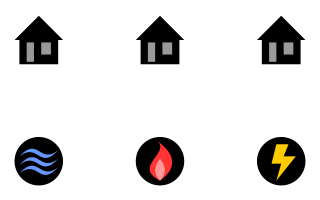 W
WThe classical mathematical puzzle known as the three utilities problem; the three cottages problem or sometimes water, gas and electricity can be stated as follows:Suppose there are three cottages on a plane and each needs to be connected to the water, gas, and electricity companies. Without using a third dimension or sending any of the connections through another company or cottage, is there a way to make all nine connections without any of the lines crossing each other?
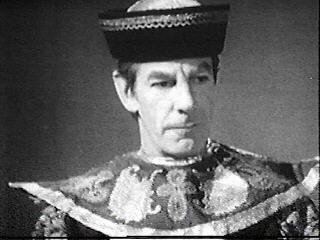 W
WThe Celestial Toymaker is the mostly missing sixth serial of the third season in the British science fiction television programme Doctor Who, which was first broadcast in four weekly parts from 2 to 23 April 1966. In it the Doctor and his companions are pitted against a powerful adversary called the Celestial Toymaker. He separates the Doctor from his companions, and all are forced to win a series of games before they can be reunited and return to the TARDIS.
 W
WVictory was a trademarked brand of plywood jigsaw puzzles, produced by G. J. Hayter & Co.
 W
WA whodunit or whodunnit is a complex, plot-driven variety of a detective story in which the puzzle regarding who committed the crime is the main focus. The reader or viewer is provided with the clues from which the identity of the perpetrator may be deduced before the story provides the revelation itself at its climax. The investigation is usually conducted by an eccentric, amateur, or semi-professional detective. This narrative development has been seen as a form of comedy in which order is restored to a threatened social calm.